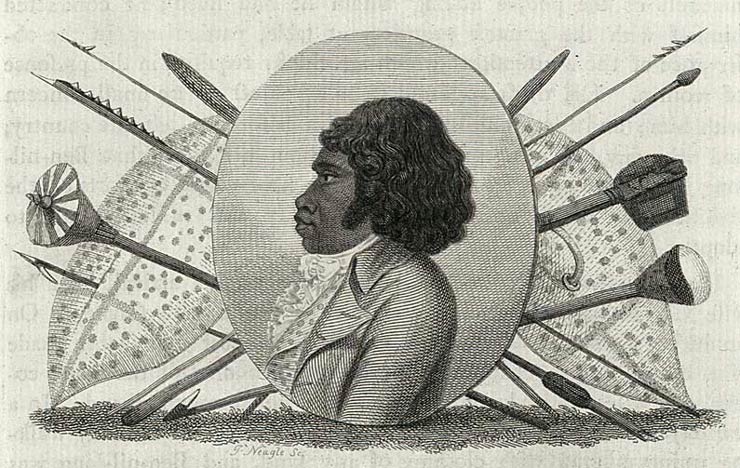Description
This is an engraving made by James Neagle in England in 1798. It features an oval portrait of Bennelong wearing a ruffled shirt, waistcoat and frockcoat. A number of Indigenous Australian weapons are depicted in a formal arrangement behind the portrait; these include two shields, a woomera (spear thrower), a hafted axe and various types of spears. The engraving's plate-mark measures 10.0 cm x 13.5 cm.
Educational value
- This asset features Bennelong, a Wangal man from the south side of the Parramatta River - the Indigenous peoples around Port Jackson had effectively avoided the British settlers, and Governor Arthur Phillip wished to establish contact with them; Bennelong was one of three captured on the orders of Phillip; he was abducted from Manly Cove in November 1789 but ran away after six months, returning in 1790 to Sydney, where he received an iron hatchet and made a verbal peace agreement with Governor Phillip; Bennelong adopted European dress and ways, learned English and tried to improve relations with the British by teaching them about Indigenous customs and language.
- It depicts Bennelong when he was in England with another Indigenous Australian man, Yemmerrawanie - the pair left Sydney with Governor Phillip in 1792 and were presented to King George III on 24 May 1793; after Bennelong returned to Australia in February 1795, he tried to persuade his family to adopt British dress and behaviour, but was rejected by his own people; he died on 3 January 1813.
- It illustrates several Indigenous Australian weapons - both sides of a painted shield are depicted (one pierced by a hunting spear), although the style of the shield's handle is not accurate; the head of a woomera (spear thrower) is on the lower left, with a multipronged fishing spear on the lower right; above these are ceremonial objects, as well as a fighting spear and hunting spear (left), and a hafted axe and two hunting spears (right); the uppermost weapon is likely to be a boomerang; the artist may have drawn the weapons from written descriptions or weapons sent to England, or copied them from other works.
- It is an example of copper engraving - engravers carve a picture onto a copper plate, use varnish to protect unscratched areas, then etch the plate in an acid bath; multiple identical images can be made by inking the finished plate and pressing it against damp paper through heavy rollers.
